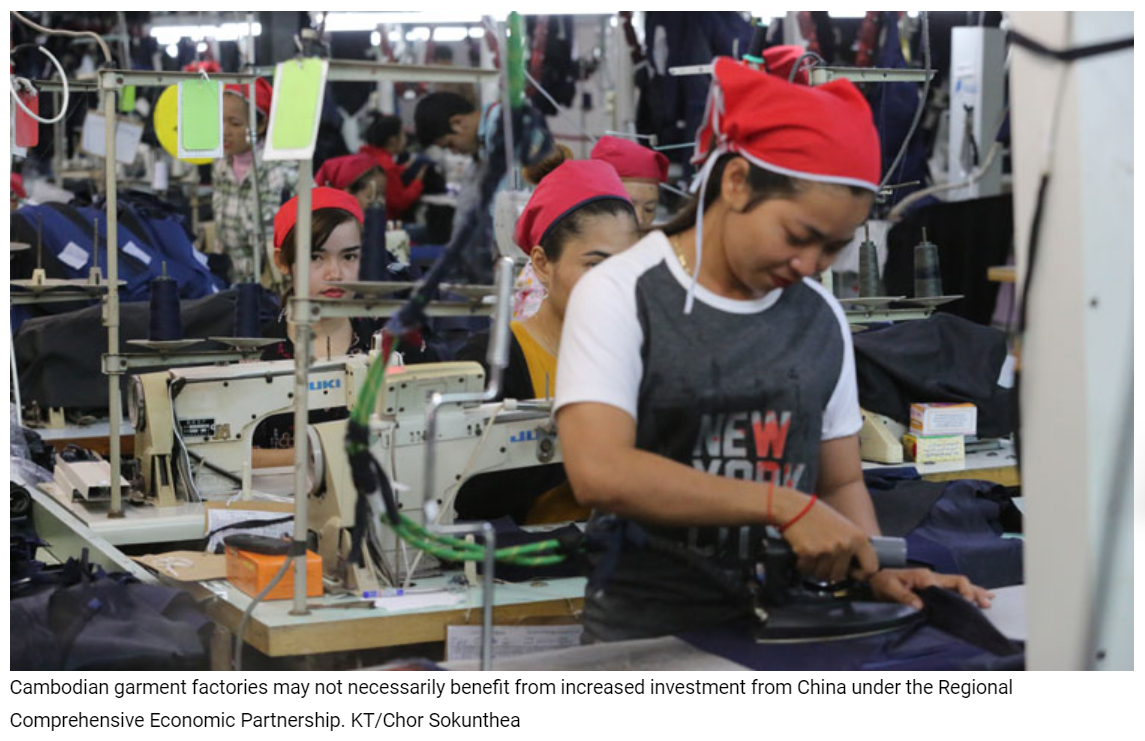Cambodia: Regional trade deal may hurt exporters, manufacturers
An Asia-wide trade agreement likely to come into force by next year may cut Cambodia’s exports and lead to a surge in imports, according to some economists. Others are more upbeat about the trading outlook for the Kingdom.
The Regional Comprehensive Economic Partnership (RCEP) will be the world’s largest free-trade bloc. After eight years of negotiation, it will come into force when ratified by at least six ASEAN countries and three non-ASEAN countries, which may come as soon as the end of this year.
Cambodia is one of the 10 ASEAN nations agreeing to trade freely with China, Australia, New Zealand, Japan and South Korea, creating a market comprising nearly one third of the world’s population, one third of global gross domestic product (GDP) and one third of the world’s total exports.
The bloc is “the fastest growing and most promising investment region in the world”, according to Zoey Zhang of Dezan, Shira & Associates, an Asia-based consultancy that advises international investors.
However, many of RCEP’s members already have bilateral free trade agreements and a top United Nations economist says they may win at Cambodia’s expense.
“According to our analyses, Cambodia’s exports [post-ratification] to RCEP countries will actually decline by around $9 million per annum because there will be a shift towards more competitive exporters in the group,” said Rashmi Banga, a senior economist at the United Nations Conference on Trade and Development (UNCTAD). “Cambodia’s imports on the other hand will increase by around $2.3 billion, worsening its balance of trade by around 17 per cent post-RCEP”, she said.
Deborah Elms, executive director of Singapore’s Asian Trade Centre (ATC), which conducts policy-oriented research on Asian trade issues, agrees that some companies may lose out but she says it’s down to the firms, not governments, to take advantage of what the deal delivers.
“Having a trade agreement in place is one variable that firms can leverage. But not every company can or will take advantage of benefits on offer. Ultimately, it is firms that use a trade agreement (or not), so what really matters is how useful they find it and how much knowledge they have on what it means for their own competitiveness,” Elms said.
“RCEP is better than existing trade agreements. It’s easier to use than trying to manage multiple different agreements and ensuring compliance with the rules in each”, she added. “Bilateral agreements, especially, can be tough for companies because they typically require that most of the product gets sourced from within just two countries – Cambodia and the partner. This can be a challenging requirement.”
Cambodia may benefit from increased investment from China as Chinese-based businesses try to take advantage of lower labour costs.
“ASEAN economies will be in a unique position to service China’s growing domestic economy with value-added consumer and intermediate products,” said Zhang. “The lower-income RCEP economies will also benefit from the significant shift of textile and apparel industries out of China to their lower cost bases,” she said.
However, UNCTAD says its economic forecasts show that Cambodia will gain little more from its relationship with China.
“Given that China already has an FTA [free trade agreement] with ASEAN countries, including Cambodia, there is no reason to believe that post-RCEP there will be any additional reason for China to increase manufacturing goods in Cambodia”, said Banga. “Furthermore, in the digital era, and given that China is emerging as a digital leader, location of value chains will no longer depend on low-cost labour. China has the largest stock of industrial robots and fastest-growing robot density in the world. In fact, in the digital world, labour costs have become irrelevant for attracting foreign investments.”
Even if investment doesn’t come from China, ATC says Cambodia could attract capital from other members of the bloc.
“RCEP implementation can make Cambodia a much more attractive destination for investment from all over Asia – not just China. There are a number of benefits that Cambodia can provide [to] investors, including local firms that are quite good at exporting,” Elms said.
Any trickle-down effect from increased investment may also be offset by the loss of revenue from RCEP members’ imports.
“Tariffs become especially important at times of crisis like the current pandemic,” said Banga. “Cambodia will experience a tariff revenue loss of around $300 million per annum. Given the limited financial resources available to a small developing country such as Cambodia, tariffs are a simple and effective policy tool in the hands of the government that can help generate additional revenue for the government. In times of crisis like the current pandemic, tariffs can be used to protect the vulnerable sectors as well as regulate the imports of luxury items. Taking binding commitments on cutting 90 percent of tariffs will not only lead to loss of fiscal space for the government but will also lead to loss of regulatory space of the government. The revenue generated from tariffs at this time of pandemic can help in vaccinating the population as well as buying the necessary medical equipment and health products,” she added.
ATC’s Elms says the loss of revenue from imports may not be totally negative for Cambodians.
“Tariffs provide revenue for the government, but they are also a tax on consumers and firms. Removing them can provide more avenues for growth. This includes new ways to find export markets in the 15 RCEP countries. Ultimately, growth is most important”, she said.
Forecasts as to when Cambodia will ratify RCEP vary from July 1 to the end of 2021. Calls and emails to the Ministry of Commerce for comment on a possible signing date went unanswered.
Source: https://www.khmertimeskh.com/50882468/regional-trade-deal-may-hurt-exporters-manufacturers/


 Thailand
Thailand




